AMD Radeon RX 6800 XT Roundup: ASRock, Asus, and Sapphire Reviewed
Factory overclocked RX 6800 XT cards that you still can't find in stock
Wrapping up our performance testing, the power and thermal results are actually more interesting than the raw performance. At least there's more variation between the cards in these areas, though all three custom cards stay reasonably cool and should run fine in any PC large enough to accommodate the hardware.
For these tests, we're using Powenetics software to gather the actual power draw of the graphics cards. GPU-Z is used to collect thermal, clock speed, and fan speed data. We also have an SPL meter that we set up 15cm from the side of the cards to capture noise. However, we don't have an anechoic chamber or anything particularly fancy. External noise (e.g., from traffic) means we have to simply eyeball the meter rather than logging data and generating a chart. We test all of these metrics using Metro Exodus, set to loop five times, and FurMark running at 1600x900 in stress test mode.
Let's quickly talk about the noise levels first. Recent changes to my office mean the new setup isn't identical to the old one, but the noise floor (when traffic isn't driving by) is now 34 dB. The SPL meter is kept close to the GPUs in order to isolate the noise from the card and not pick up as much fan noise from the CPU cooler, though differences in card design can be a factor. All of the latest GPUs support 0 dB fan technology, which means idle noise levels are all the same: 34 dB. Literally any other noise, like typing or someone walking around, registers at much higher levels than that, so it's pretty quiet.
Under load, the GPUs start to show their differences. For example, the Asus has two large 120mm fans on the radiator that move quite a bit of air, while the third fan on the card itself is basically silent. Asus ended up being the loudest of the three GPUs in the gaming test, measuring 45.6 dB peak and generally hovering in the 43-45 dB range, but the actual fan noise tends to be lower and, to my ears at least, not as noticeable as smaller fans. ASRock peaked at 44.5 dB in gaming, again with a range of around 41-44 dB. Sapphire showed the most variation, running as quiet as 37 dB but peaking at 42.1 dB.
Results under FurMark are more consistent, but the cards deal with the extreme power draw in different ways. As a result, ASRock was the loudest card in FurMark, peaking at 45.6 dB and basically staying in the 45+ dB range. Asus came in second at 44.1 dB, while the Sapphire card was the quietest of the three and only ran at 39.5 dB. Again, we didn't make charts because it's just the three cards, but none of the cards are particularly loud. Pay attention to the actual GPU clocks and thermals below when looking at noise levels, however, as all of these metrics are interrelated.
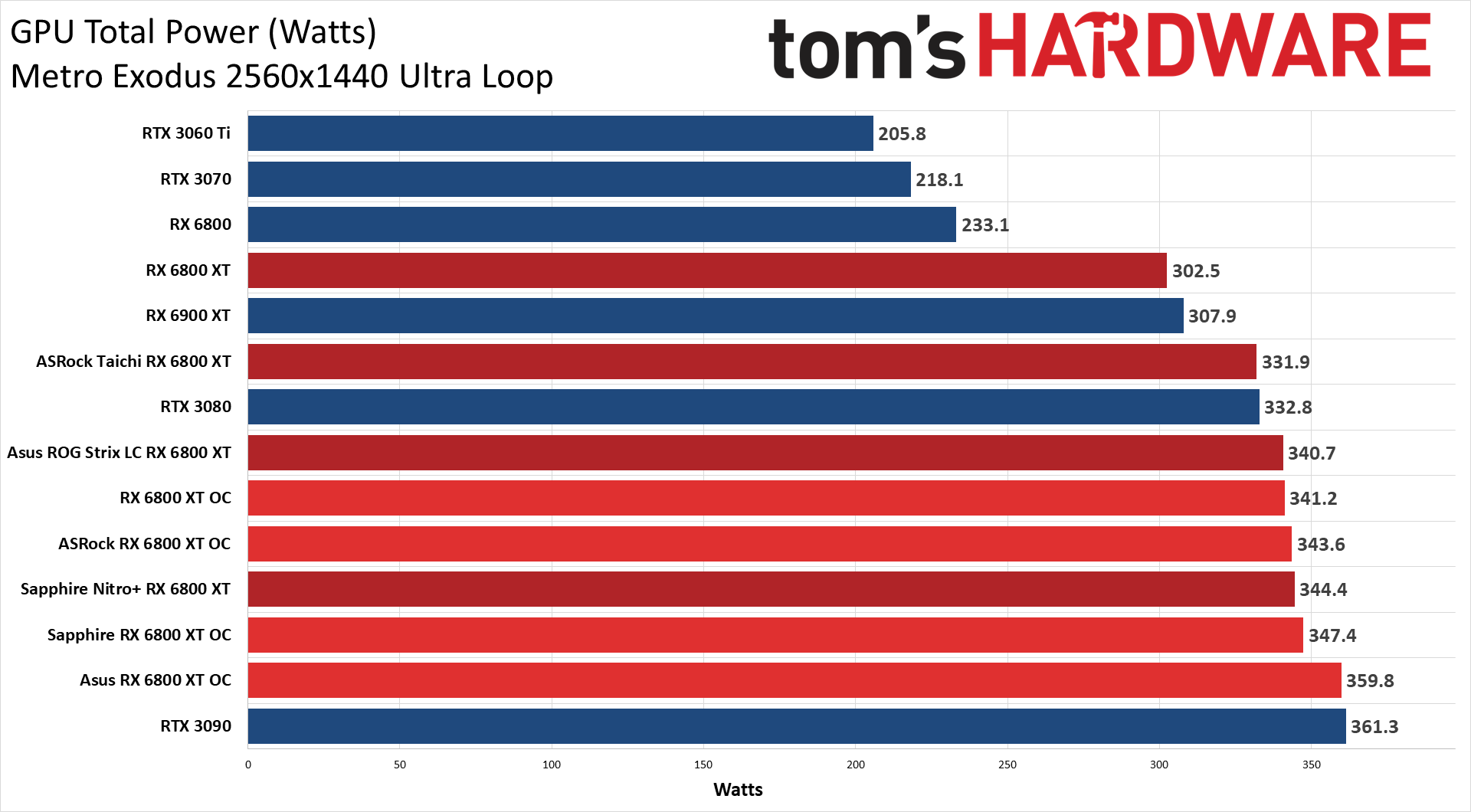
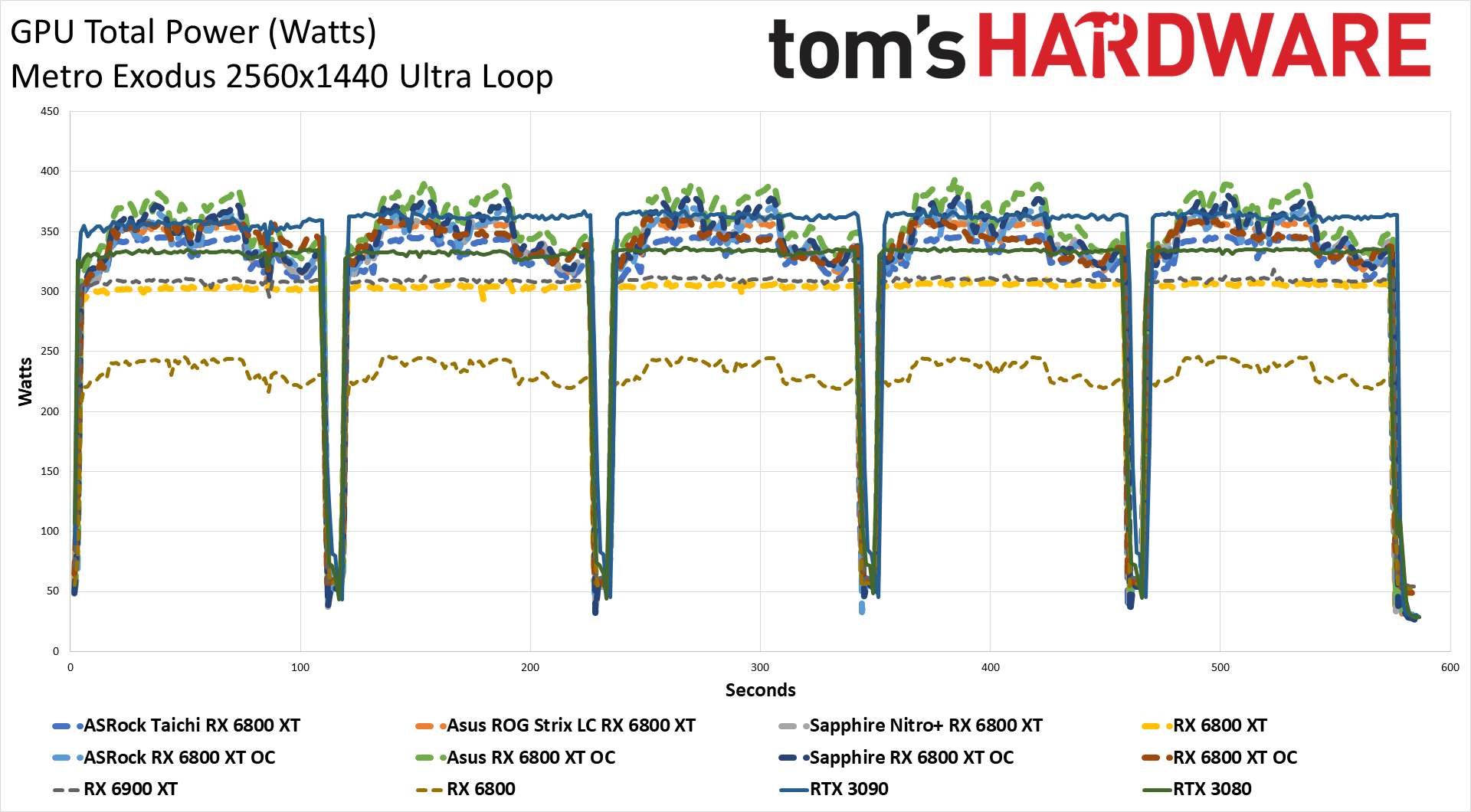
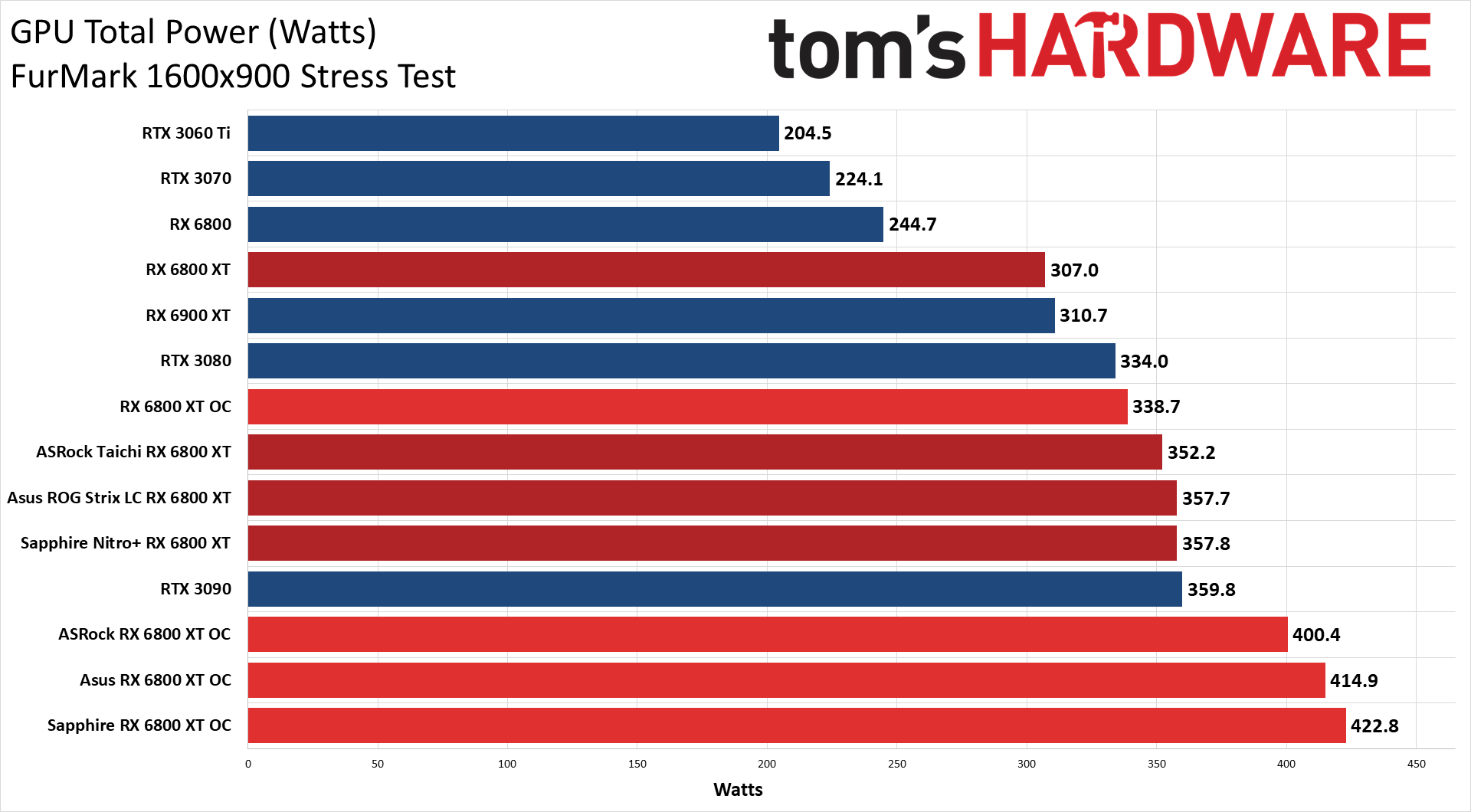
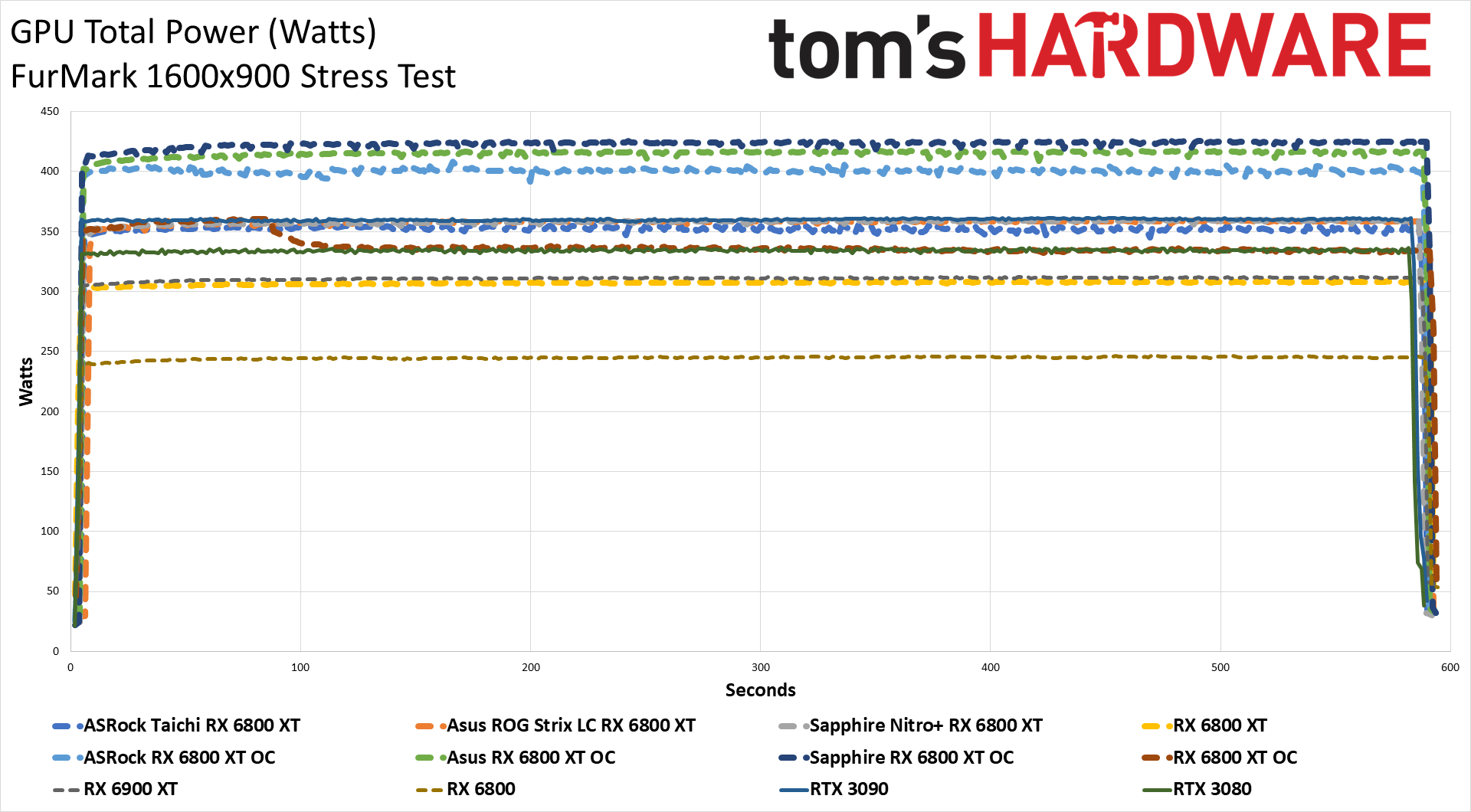
As mentioned earlier, the three custom AIB cards all have higher power use than the reference 6800 XT. In the Metro test, the ASRock uses the least power at around 332W, 30W more than the reference model. The Asus card uses 341W, though it has a pump and two larger fans on the radiator that undoubtedly use more power than the three smaller fans used on the other two cards. The Sapphire card ends up with the highest power use of 344W, which is as much as some of the other cards use even when overclocked. Overclocking isn't even that bad when you consider that performance improves by 4-7 percent (in Metro), while power use increases 1-6 percent. (Except for the reference card, which used 13 percent more power.)
FurMark takes power use to even higher values, ranging from 352W for the ASRock to 358W on the Asus and Sapphire cards. Overclocking pushes the three cards into the 400W and higher range, again with Sapphire using the most power of the 6800 XT models.
Get Tom's Hardware's best news and in-depth reviews, straight to your inbox.
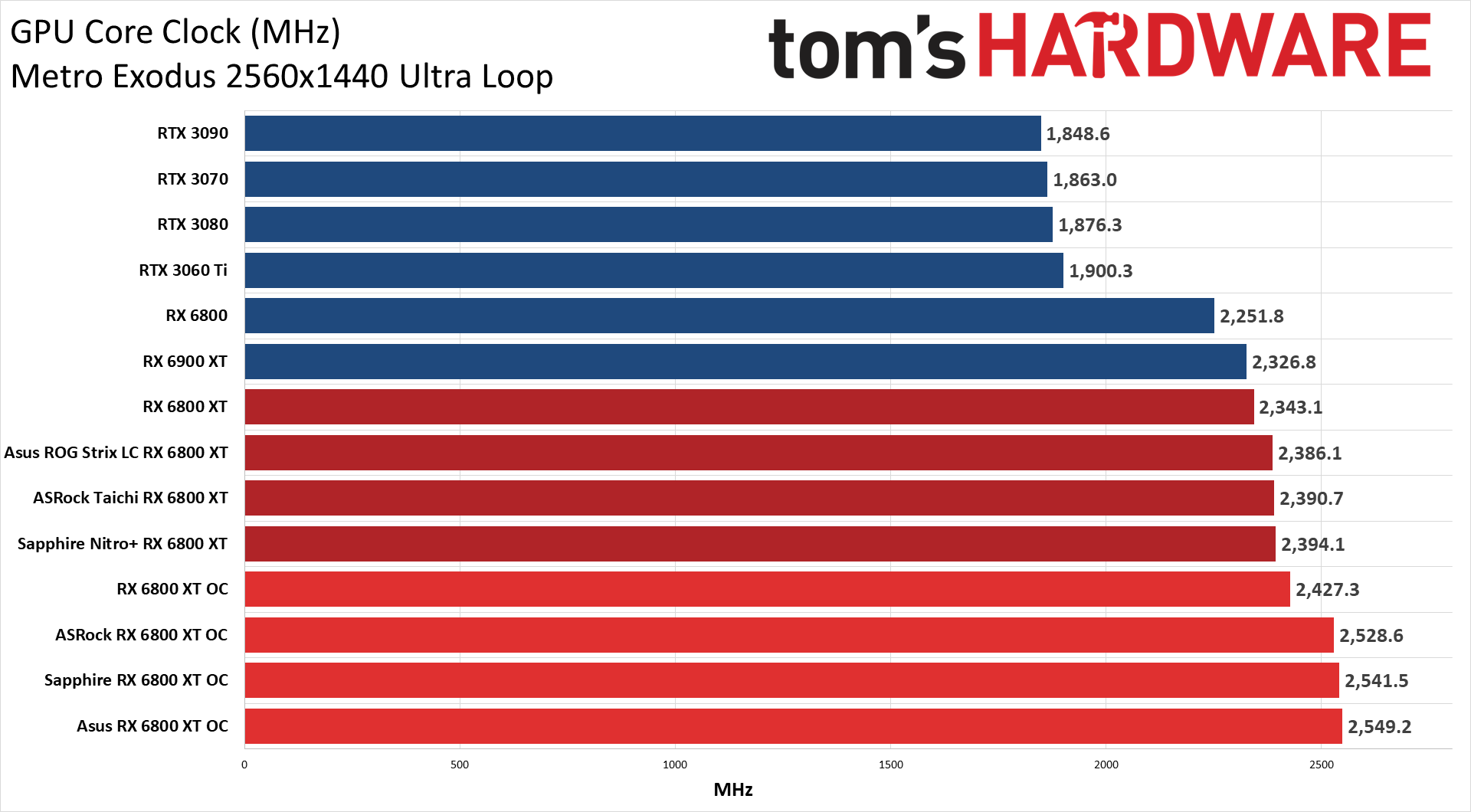
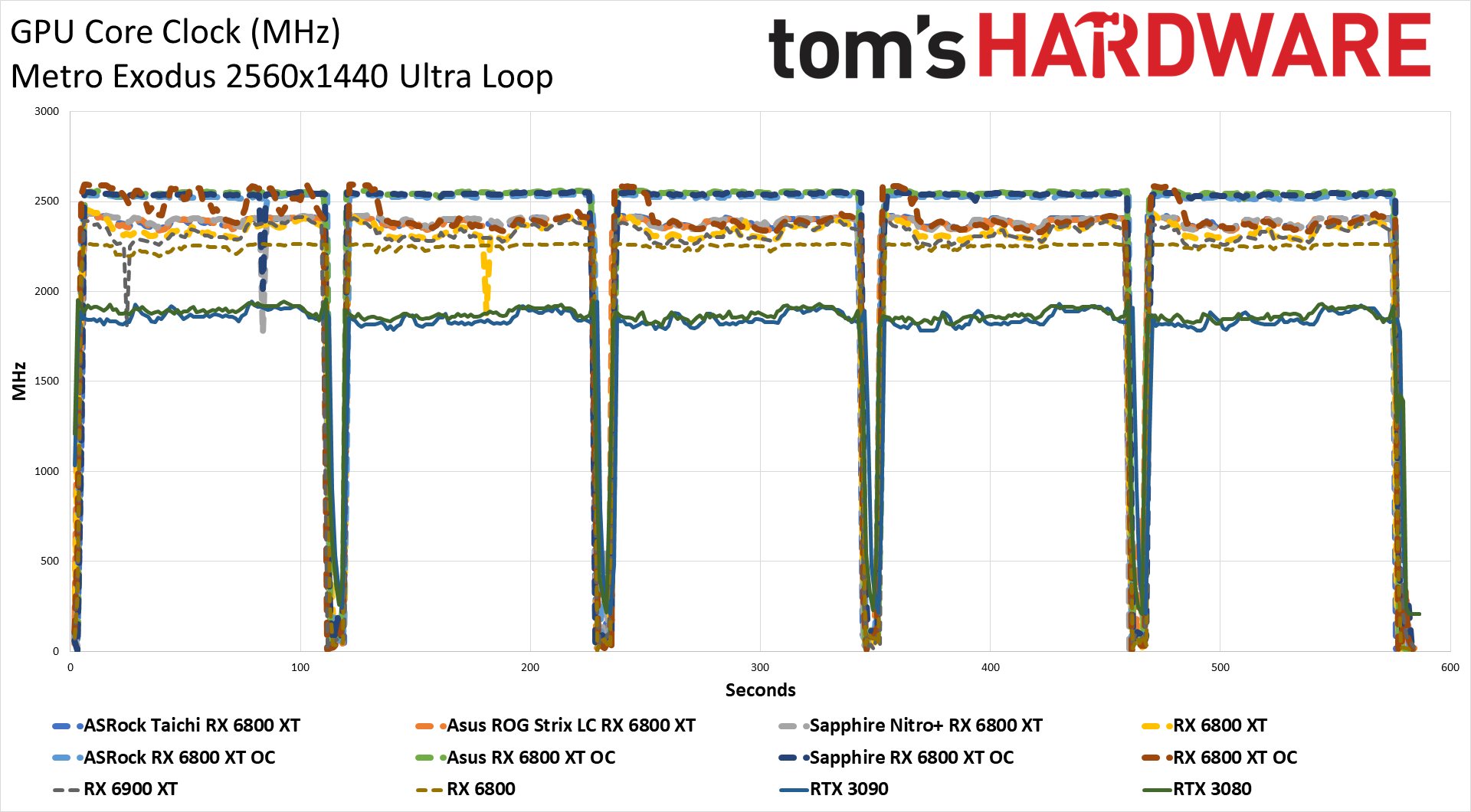
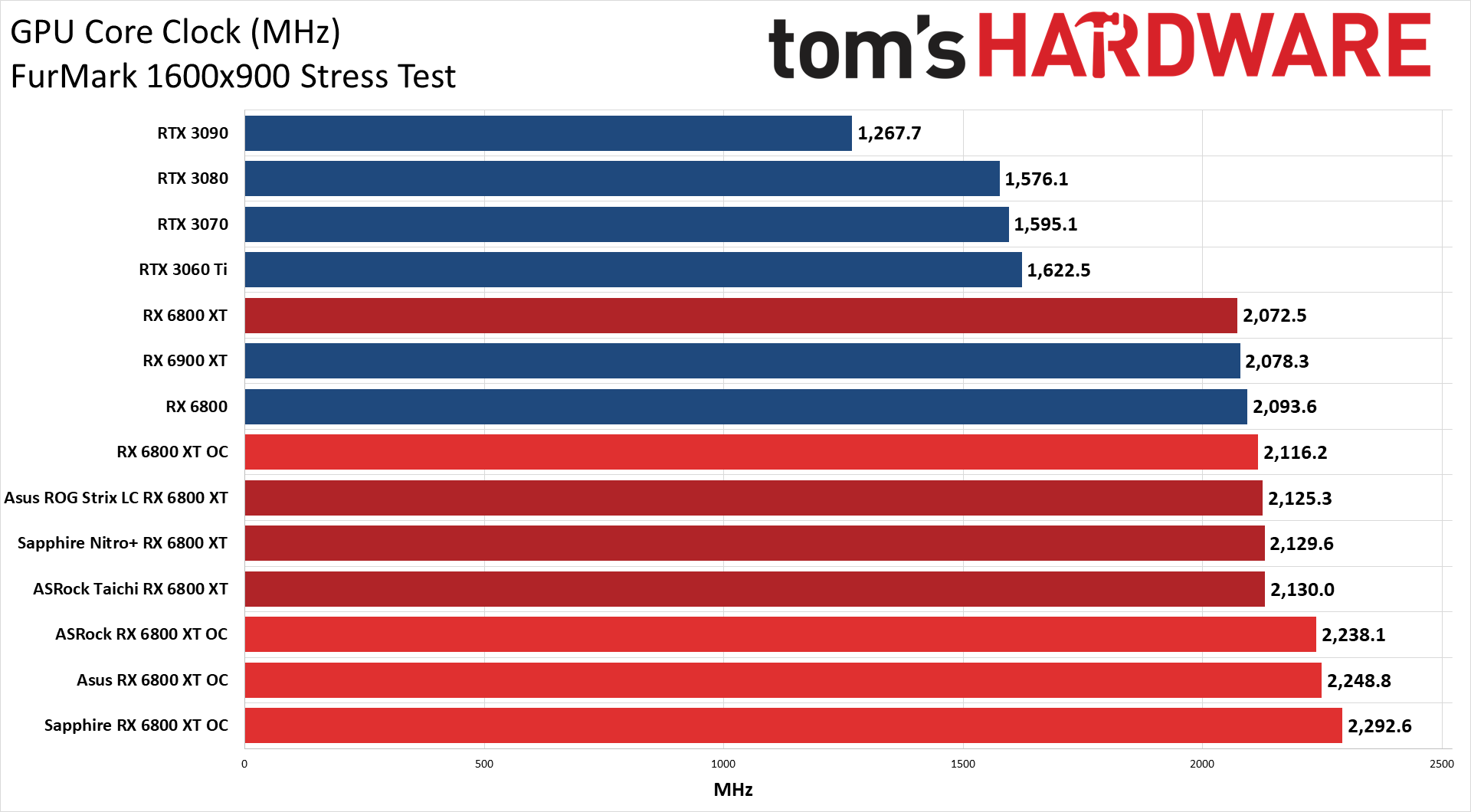
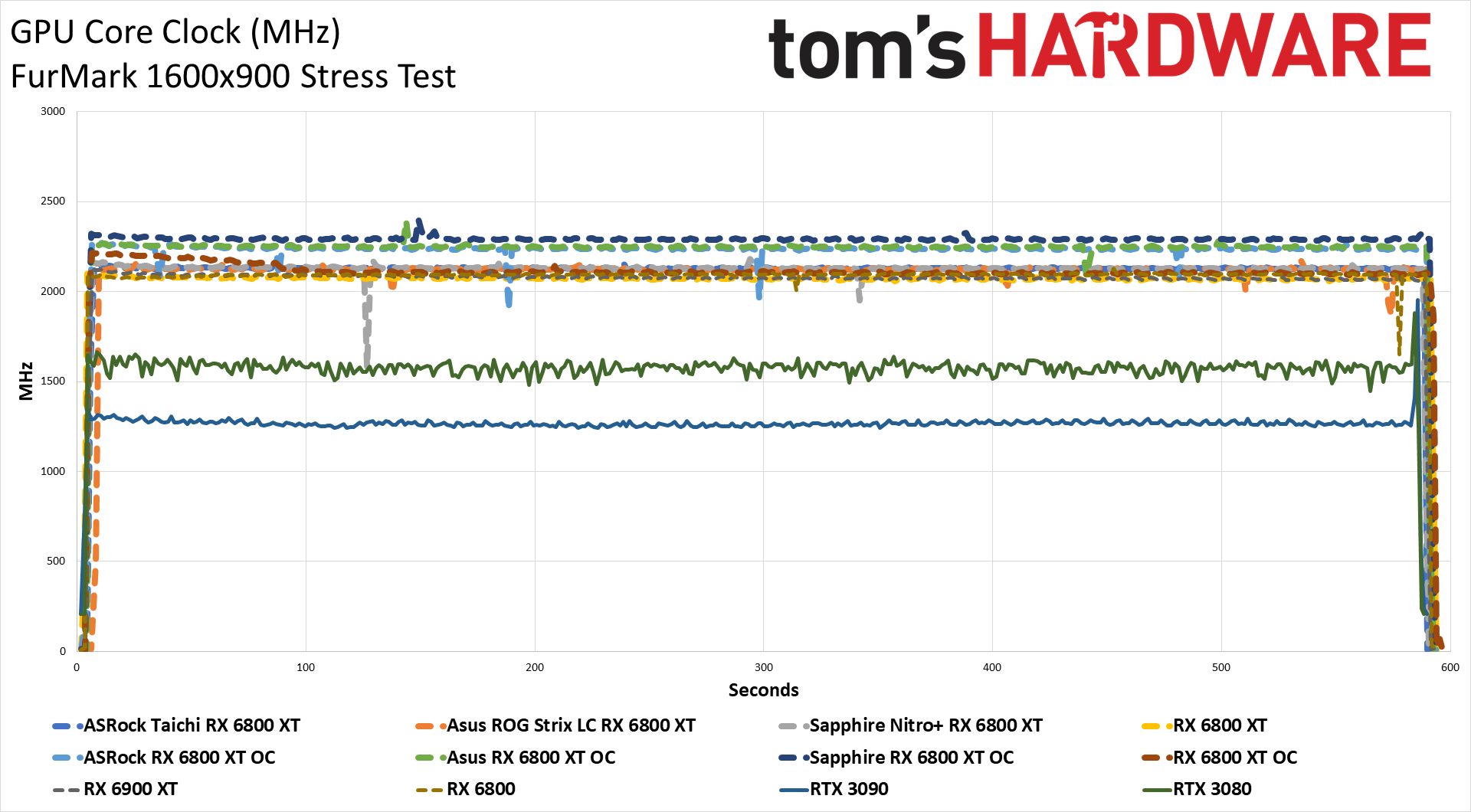
At factory stock settings, all of the RX 6800 XT cards meet or exceed the official boost clock, though in-game clocks will vary by game. In Metro, the custom cards reach 2386-2394 MHz average clocks, with overclocking pushing all three cards into the 2500 MHz and higher range. FurMark is a different story, with the GPUs reigning in clocks in order to keep thermals and power use in check, but 2.1GHz while running FurMark is still quite impressive, and overclocking takes that up to around 2.25GHz.
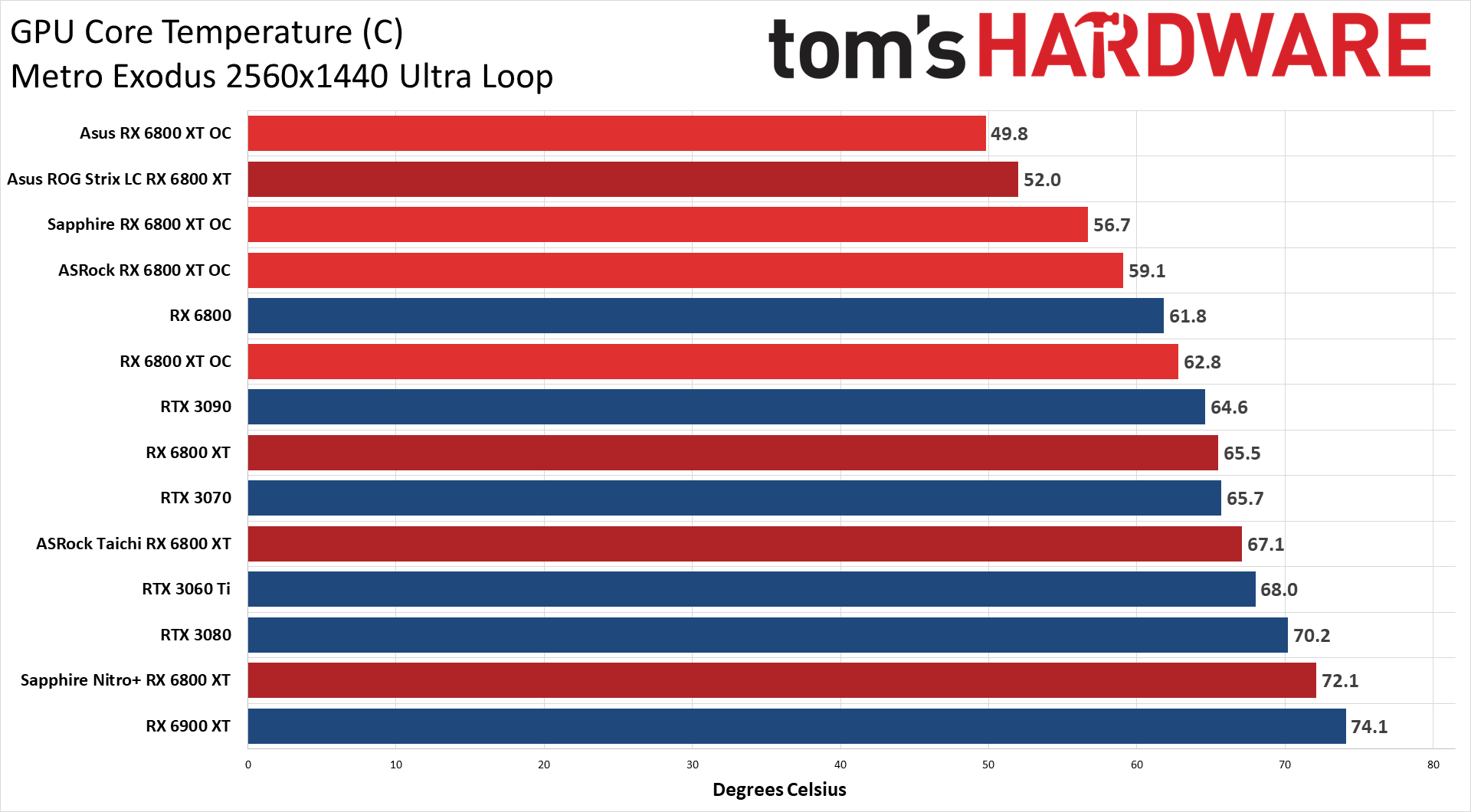
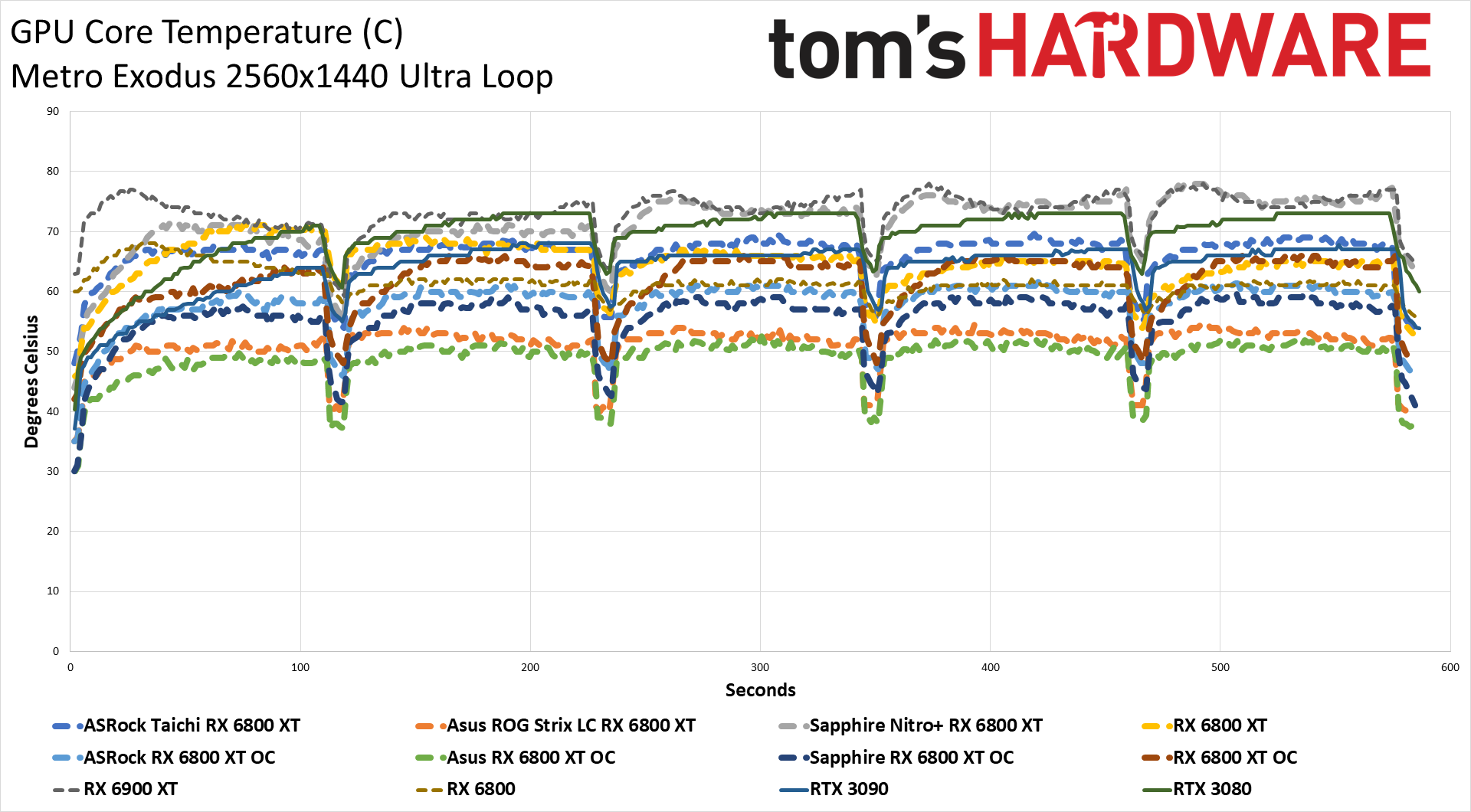

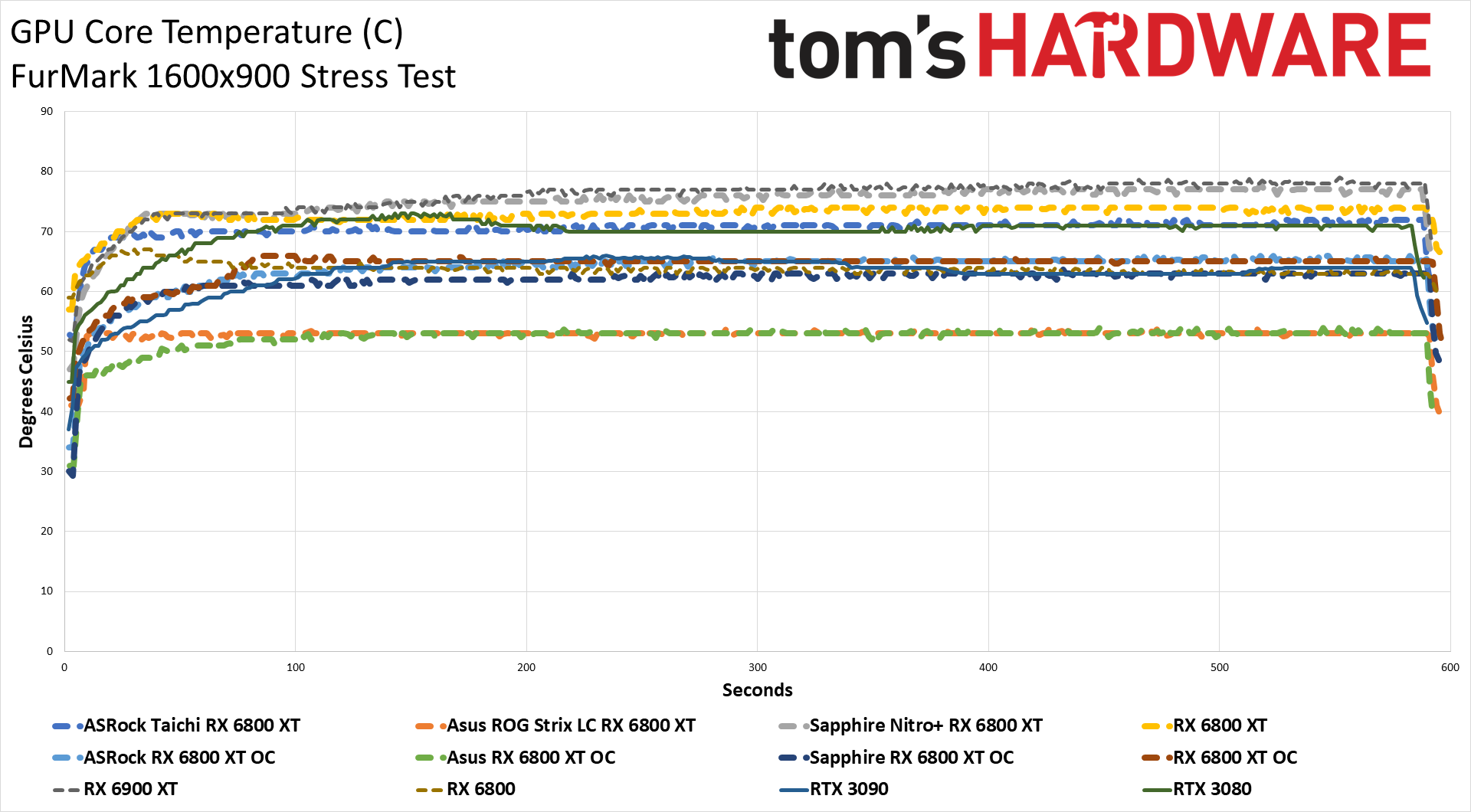
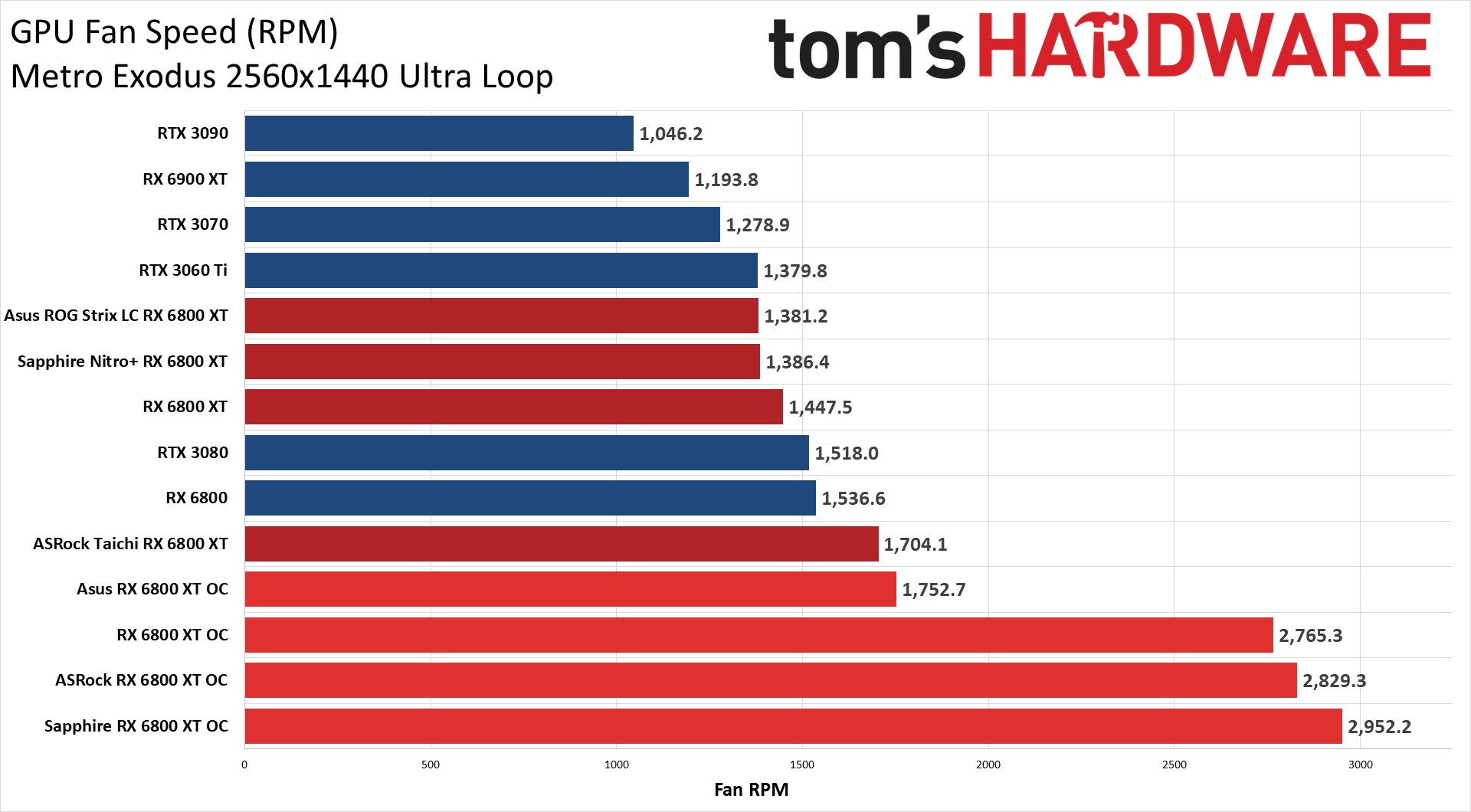
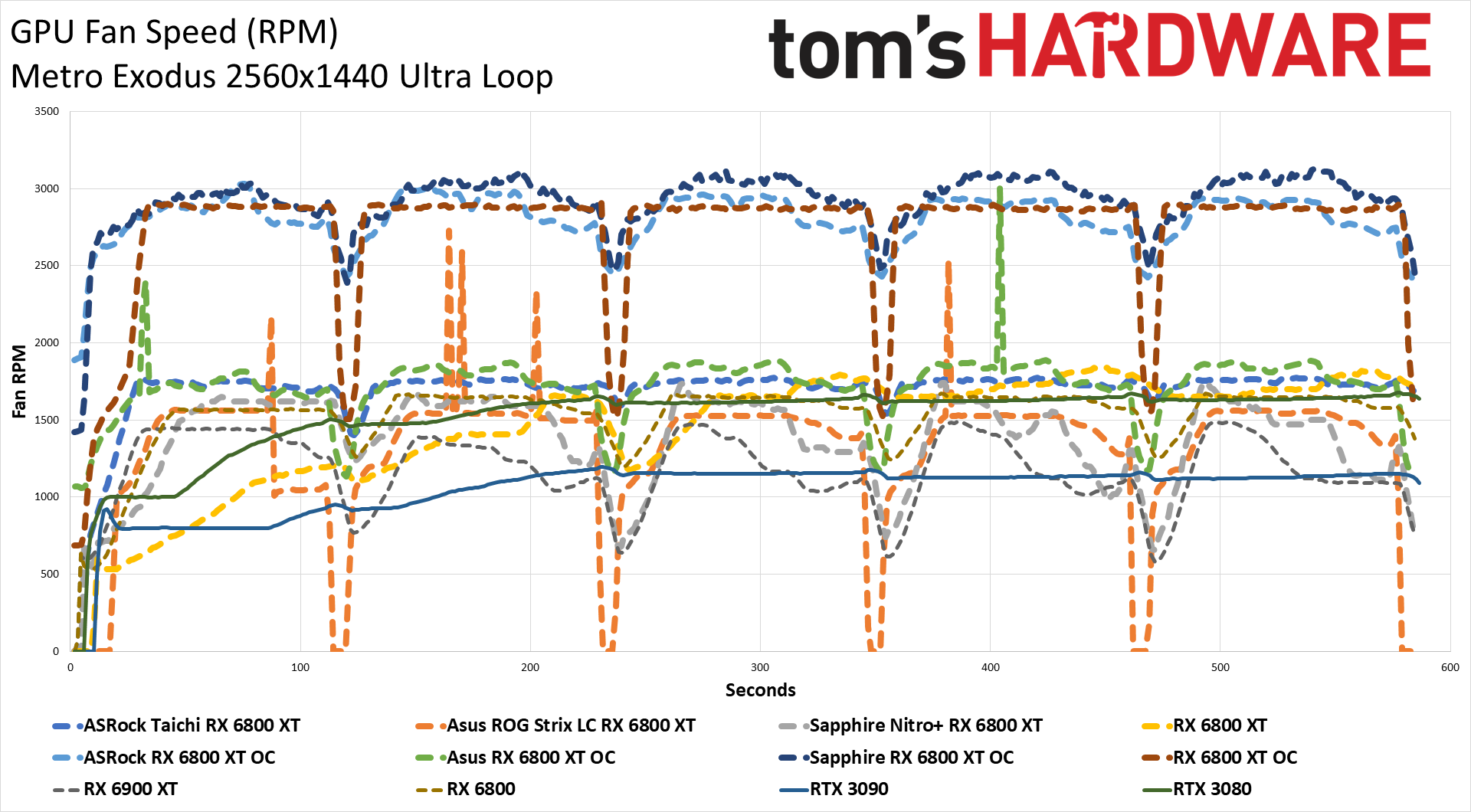


Temperatures have a direct correlation with fan speed and noise, so they can't be considered on their own. As noted earlier, the Asus card had the highest noise levels, and while the fan speeds are quite low, two large 120mm fans still move a lot of air and can create more noise and turbulence than three 90mm fans. Still, the Asus runs over 15C cooler than the other custom cards in Metro, and over 17C cooler in FurMark, all while hitting similar clocks. Somewhat surprisingly, the Sapphire card has lower fan speeds than the ASRock but tends to be just as loud while running a bit hotter. Still, 72-75C isn't particularly high for a high-end GPU playing a demanding game.
You can also see how the significant ramp in fan speed to help with overclocking affects things. Temperatures are actually lower than stock, but that's because overclocking puts enough of a strain on the GPU that we didn't want to risk instability in pursuit of lower noise levels. If you want low thermals with a decent overclock, the Asus liquid cooler ends up being far superior to traditional air cooling.
MORE: Best Graphics Cards
MORE: Desktop GPU Performance Hierarchy Table
MORE: All Graphics Content
Current page: Radeon RX 6800 XT Roundup: Power, Thermals, Clocks, Fans, and Noise
Prev Page Radeon RX 6800 XT Roundup: 4K Gaming Benchmarks Next Page Radeon RX 6800 XT Roundup: Closing Thoughts
Jarred Walton is a senior editor at Tom's Hardware focusing on everything GPU. He has been working as a tech journalist since 2004, writing for AnandTech, Maximum PC, and PC Gamer. From the first S3 Virge '3D decelerators' to today's GPUs, Jarred keeps up with all the latest graphics trends and is the one to ask about game performance.
-
Makaveli Canadian pricing for these cards. Asrock from newegg.ca and the last two from canada computers.Reply
ASRock Radeon RX 6800 XT Taichi Gaming $1499
SAPPHIRE NITRO+ Radeon RX 6800 XT $1149
ASUS ROG STRIX LC Radeon RX 6800 XT $1299
And for the money Asus is asking for this card, they could have alteast sleeved those fan cables its mess. For $1000+ asking price kinda of a slap in the face. -
Jobeker Your testing methodology is flawed.Reply
The memory should not be overclocked in these cards.
These cards show much better results once you push the GPU to the max & leave the memory at stock.
It seems that you & all the other testers I have come to respect in almost 2 decades of reading tests & benchmarks , have become fixated on maxing the mem to the point of "no crush" without even comparing the results.
I hope you still have at least one of the cards at hand to make 1 more test, you will see that stock mem@2000mhz + GPU@2600mhz gets much better results than mem@2140mhz + GPU@2600mhz .
I am active on a different language forum & a local system builder/fine tuner corroborated these results with several different 6800XT cards.
( he is the one that Identified this issue , I don't own such a card at the moment)
He is now testing a 6900XT .
As a bonus , once you leave the memory at stock you get a few extra watts for higher gpu oc.
I don't care that much about the actual value of the specific cards ( definitely not at current pricing ) it is however very important for me to make sure you testing methodology isn't flawed.
I seriously hope you still have one of the cards for one more test . -
JarredWaltonGPU Reply
Define "much better results" for me, please. The overclocking is not supposed to be the major focus, because silicon lottery and other elements come into play. Frankly, I wouldn't bother overclocking most GPUs -- it's just not enough of a gain to warrant the added power and potential stress on the hardware. Anyway, a 7.5% memory OC isn't much, and neither is the 3-7% increase in performance I measured with the 'max' OC I achieved.Jobeker said:Your testing methodology is flawed.
The memory should not be overclocked in these cards.
These cards show much better results once you push the GPU to the max & leave the memory at stock.
It seems that you & all the other testers I have come to respect in almost 2 decades of reading tests & benchmarks , have become fixated on maxing the mem to the point of "no crush" without even comparing the results.
I hope you still have at least one of the cards at hand to make 1 more test, you will see that stock mem@2000mhz + GPU@2600mhz gets much better results than mem@2140mhz + GPU@2600mhz .
I am active on a different language forum & a local system builder/fine tuner corroborated these results with several different 6800XT cards.
( he is the one that Identified this issue , I don't own such a card at the moment)
He is now testing a 6900XT .
As a bonus , once you leave the memory at stock you get a few extra watts for higher gpu oc.
I don't care that much about the actual value of the specific cards ( definitely not at current pricing ) it is however very important for me to make sure you testing methodology isn't flawed.
I seriously hope you still have one of the cards for one more test .
Dropping the memory OC and trying for a slightly higher core OC is totally within the parameters of what can be done, and may improve performance more than what I've shown. More effort on tuning voltages, fan speeds, etc. could also improve performance. Without physically modding the cards, though, I strongly doubt you'll see more than a 5% improvement over what I achieved, which is a 10% potential total improvement. In practice, I'm sure it would be far less than that -- probably only a 1-2% difference from my max core + max RAM OC results. And there's a very good chance that, despite what you're positing, overclocking the memory actually does improve performance.
Let me give you just one example, because based on this I see no reason to bother retesting anything more.
SettingAsus Strix LC RX 6800 XT OCAsus Strix LC RX 6800 XT OC StockRAMAsus Strix LC RX 6800 XTMetro Exodus1080p Ultra125.09123.2119.46
1440p Ultra105.43103.6999.77
4k Ultra69.4468.5264.81
So, in at least one game, using the same card in all three cases (the Asus Strix LC), dropping the RAM OC but leaving the GPU at the same 2600 MHz setting reduced performance by 1-2%. So much for my "flawed" methodology. -
shady_021 The only thing I see here is all 6800 XT are equal or slightly ahead of a 6900 XT... so except for the price difference what's the point of having a 6900XT?Reply -
JarredWaltonGPU Reply
The overclocked RX 6800 XT cards match the stock RX 6900 XT. If I overclocked the 6900 XT as well, it comes out a bit ahead again.shady_021 said:The only thing I see here is all 6800 XT are equal or slightly ahead of a 6900 XT... so except for the price difference what's the point of having a 6900XT?
This is something I pointed out in the RX 6900 XT review: it has identical clocks, TDP, and VRAM, so the only difference is 80 CUs instead of 72 CUs. That means at most an 11% advantage for the 6900 XT, but because of VRAM being the same it is usually more like 4-5%. So it's not really worth the extra $350, except none of the 6800 XT cards cost $649, and none of the 6900 XT cards cost $999 -- and in fact, neither of those really exists in any meaningful quantity AFAICT. Tens of thousands of cards worldwide perhaps, but that's a drop in the proverbial bucket. -
Jobeker JarredWaltonGPU , Thank you for taking interest in my comment & performing the relevant tests.Reply
I've ( we actually ) been fed with a lot of information in the past 2 weeks that led me to believe the claim I made .
I apologize that it came out rude.
I trust your findings better .
Thank you. -
HC1Gunner Reply
Question, how is this a round up, when other manufactures like Gigabyte weren't included?Admin said:We've rounded up multiple Radeon RX 6800 XT cards to see how the various models stack up. Higher factory overclocks, liquid cooling hybrids, massive coolers, and increased pricing are the general trend while GPUs continue to be in short supply.
AMD Radeon RX 6800 XT Roundup: ASRock, Asus, and Sapphire Reviewed : Read more
Kind of stupid to do these reviews, when you can't find any of these cards for retail sale. -
pbergonzi Reply
Thank you for your thoughtful testing and article.Admin said:We've rounded up multiple Radeon RX 6800 XT cards to see how the various models stack up. Higher factory overclocks, liquid cooling hybrids, massive coolers, and increased pricing are the general trend while GPUs continue to be in short supply.
AMD Radeon RX 6800 XT Roundup: ASRock, Asus, and Sapphire Reviewed : Read more -
JarredWaltonGPU Reply
A roundup isn't every card or manufacturer possible; it's a roundup of the cards we were sent. So rather than three individual 6800 XT reviews, you get a roundup of three cards plus the reference model.HC1Gunner said:Question, how is this a round up, when other manufactures like Gigabyte weren't included?
Kind of stupid to do these reviews, when you can't find any of these cards for retail sale.